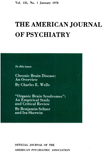A FOLLOW-UP STUDY OF 618 SUICIDAL PATIENTS
Abstract
In this study, 618 suicidal veteran patients were followed up for a period of one month to 14½ years, averaging 4.6 years. Of these, 615 were successfully traced. Twenty-one of these (3.4 percent), all males, had committed suicide.
By computation of man-years of risk for each case and summing of these by categories, the following suicide rates were derived (to be compared to 10.6 for the U.S. as a whole and 22.7 for male veterans) : all 615 subjects, 740; male suicidal patients, 786; suicide attempts, 805; suicide threats, 710; suicidal ideas, 674.
Rates were also derived and presented for diagnostic groupings, age, length of time in the study, degree of seriousness of the suicidal behavior, severity of the symptom of depression and type of precipitating factor.
The period of greatest risk of suicide was found to be during the first two years following the initial suicidal behavior; during the first three months, the incidence of suicide was almost one percent of the entire group.
It is concluded that suicidal behavior (attempts, threats and ideas) is one of the strongest indicators of future suicide —more relevant than the psychiatric diagnostic grouping. Male patients who have shown such behavior have about 35 times the expected suicide rate.
Access content
To read the fulltext, please use one of the options below to sign in or purchase access.- Personal login
- Institutional Login
- Sign in via OpenAthens
- Register for access
-
Please login/register if you wish to pair your device and check access availability.
Not a subscriber?
PsychiatryOnline subscription options offer access to the DSM-5 library, books, journals, CME, and patient resources. This all-in-one virtual library provides psychiatrists and mental health professionals with key resources for diagnosis, treatment, research, and professional development.
Need more help? PsychiatryOnline Customer Service may be reached by emailing [email protected] or by calling 800-368-5777 (in the U.S.) or 703-907-7322 (outside the U.S.).



